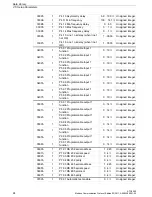
General Information
1.11 Function 16: Preset Multiple Register
ATC5300
12
Modbus Communication Protocol, Edition 03/2011, A5E02469001-02
1.11
Function 16: Preset Multiple Register
This function allows to modify multiple parameters with a single message, or to preset a value
longer than one register. The address and the valid range for each parameter are stated in
Table 3.
Master message:
Slave response:
1.12
Modbus
®
ASCII Protocol
The Modbus® ASCII protocol is normally used in application that require to communicate
through a couple of modems. The functions and addresses available are the same as for the
RTU version, but the transmitted characters are in ASCII and the message end is delimited by
carriage return / line feed instead of a transmission pause.
If one selects the parameter P7.04 and / or P7.07 as Modbus® ASCII protocol, the
communication message on the correspondent communication port has the following
structure:
•
The Address field holds the serial address of the slave destination device.
•
The Function field holds the code of the function that must be executed by the slave.
•
The Data field contains data sent to the slave or data received from the slave in response
to a query. The maximum allowable length is of 60 consecutive registers.
•
The LRC field allows the master and slave devices to check the message integrity. If a
message has been corrupted by electrical noise or interference, the LRC field allows the
devices to recognize the error and thereby ignore the message.
•
The message terminates always with CRLF control character (0D 0A).
Slave address
08h
Function
10h
MSB register address
20h
LSB register address
01h
MSB register number
00h
LSB register number
02h
MSB data
06h
LSB data
F4h
MSB data
06h
LSB data
83h
MSB CRC
55h
LSB CRC
3Ah
Slave address
08h
Function
10h
MSB register address
20h
LSB register address
01h
MSB byte number
00h
LSB byte number
04h
MSB CRC
9Bh
LSB CRC
53h
:
Address
(2 chars)
Function
(2 chars)
Dates
(N chars)
LRC (2 chars)
CR LF













































